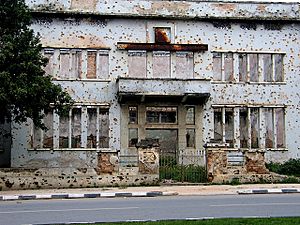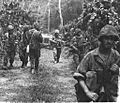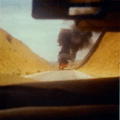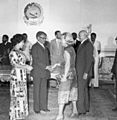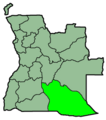Angolan Civil War facts for kids
Quick facts for kids Angolan Civil War |
|||||||
|---|---|---|---|---|---|---|---|
| Part of the Cold War and the South African Border War | |||||||
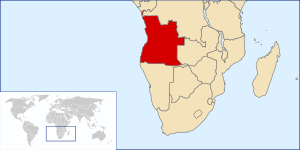 |
|||||||
|
|||||||
| Belligerents | |||||||
Supported by: |
Supported by: |
||||||
| Commanders and leaders | |||||||
| Strength | |||||||
|
|
|
||||||
| Casualties and losses | |||||||
|
|
|
||||||
| Over 500,000 civilians killed | |||||||
The Angolan Civil War was a long and difficult civil war in the African country of Angola. It started in 1975 and lasted until 2002. The war began right after Angola became independent from Portugal in November 1975.
The main fight was between two groups that used to work for Angola's freedom. These were the People's Movement for the Liberation of Angola (MPLA) and the National Union for the Total Independence of Angola (UNITA). Other countries also got involved because they wanted their own ideas to win. This made the Angolan war a part of the larger Cold War. In 2002, the MPLA group won the war.
More than 500,000 people lost their lives during the war. The fighting also caused a lot of damage to buildings and cities in Angola. Because of all the damage, many Angolans did not have basic medical care or clean water in 2003. Also, many children did not live to be five years old.
| Top - 0-9 A B C D E F G H I J K L M N O P Q R S T U V W X Y Z |
What Caused the Angolan Civil War?
Angola's Fight for Freedom
For a very long time, starting in 1575, Portugal ruled parts of what is now Angola. Before that, some of the land was part of the Kingdom of Kongo. Over the years, many Angolans wanted to be free from Portuguese rule.
Groups Fighting for Independence
Several groups formed to fight for Angola's freedom. These groups were called liberation movements. They all wanted Angola to be independent, but they had different ideas about how the country should be run afterwards. The main groups were the MPLA, UNITA, and FNLA.
The MPLA (People's Movement for the Liberation of Angola)
The MPLA was a group that believed in Communism. Their leader was a person named Agostinho Neto. They got help and support from the Soviet Union and Cuba.
UNITA (National Union for the Total Independence of Angola)
UNITA was a group that was against communism. Their leader was Jonas Savimbi. They also fought for Angola's freedom.
FNLA (National Liberation Front of Angola)
The FNLA was another group that was against communism. Their leader was Holden Roberto. The United States gave them money to help their cause.
The War Begins
Angola Becomes Independent
In 1975, Portugal signed an agreement with the MPLA, UNITA, and FNLA. This agreement was called the Alvor Agreement. It said that Angola would become an independent country on November 11, 1975.
Fighting After Independence
Even though Angola became independent, the three main groups could not agree on how to share power. This disagreement quickly led to a full-scale civil war. Each group wanted to be in charge of the new country.
Outside Countries Get Involved
Because the Angolan Civil War was happening during the Cold War, other powerful countries got involved. The Soviet Union and Cuba supported the MPLA. The United States and South Africa supported UNITA and FNLA. This made the war even bigger and more complicated.
The Long Years of Conflict
The war lasted for a very long time, from 1975 to 2002. There were many battles and peace talks, but the fighting often started again.
The 1980s: Intense Fighting
During the 1980s, the fighting was very intense. Many countries sent soldiers or weapons to help their chosen side. South African and Cuban troops were especially involved in major battles.
The 1990s: Attempts at Peace
In the 1990s, there were several attempts to make peace. Agreements were signed, but they often broke down. The war continued, causing more suffering for the Angolan people.
The War Ends in 2002
The war finally ended in 2002. The leader of UNITA, Jonas Savimbi, was killed. After his death, UNITA signed a peace agreement with the MPLA government. This brought an end to almost three decades of fighting.
What Happened After the War?
Damage and Challenges
The Angolan Civil War left a lot of damage. Many buildings, roads, and bridges were destroyed. It was hard for people to get basic things like food, water, and medicine.
Landmines
One of the biggest problems left by the war is landmines. These are hidden bombs buried in the ground. Even after the war ended, landmines continued to explode, hurting or killing people, especially children. Many groups are working to clear these dangerous mines.
Images for kids
-
Burning MPLA staff car destroyed in the fighting outside Novo Redondo, late 1975
-
Agostinho Neto, MPLA leader and Angola's first president, meets with Poland's ambassador in Luanda, 1978
-
Savimbi meeting the European Parliament deputies in 1989
-
More than 700 villagers trekked 60 kilometres (37 mi) from Golungo Alto to Ndalatando (red dot), fleeing a UNITA attack. They remained uninjured.
See also
 In Spanish: Guerra civil angoleña para niños
In Spanish: Guerra civil angoleña para niños


